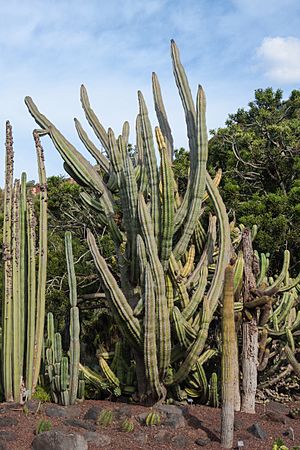Mexican organ pipe facts for kids
Quick facts for kids Mexican organ pipe |
|
|---|---|
 |
|
| Stem and fruit of Stenocereus griseus | |
| Scientific classification | |
| Genus: |
Stenocereus
|
| Species: |
griseus
|
| Synonyms | |
|
|
Stenocereus griseus, also known as the Mexican organ pipe cactus, is a tall, tree-like plant. It's also called the dagger cactus, pitaya, or pitayo de mayo. This cactus is known for its tasty fruit and its strong, spiny stems.
Contents
What it Looks Like
This cactus can grow very tall, sometimes reaching up to 9 meters (about 30 feet) high. Its main stems can be as wide as 12 centimeters (about 5 inches). The fruit of this cactus comes in different colors, including white, yellow, red, and even a rare purple.
Where it Grows
You can find the Stenocereus griseus cactus in different parts of the world. It grows in Mexico, especially in areas like Oaxaca and Veracruz. It's also found along the coast of Venezuela and in the Guajira Peninsula of Colombia. This cactus also lives on the ABC islands (Aruba, Bonaire, and Curaçao) in the Dutch Caribbean. It usually grows in dry, bushy areas called scrub-lands.
How it Helps Nature
On the Caribbean islands of Aruba, Curaçao, and Bonaire, this cactus is very important. It produces many flowers and fruits, especially during the dry season. This makes it a vital food source for many animals. Bats, birds, and other creatures rely on its fruit when other food might be scarce.
How People Use It
The fruit of the Stenocereus griseus cactus is safe for humans to eat and is considered very delicious. People also plant this cactus for its beauty in warm places. Because it has many spines, it's often used as a living fence. These spiny fences can keep animals out of certain areas.
Its Conservation Status
The Stenocereus griseus cactus is listed in CITES Appendix II. This means that its trade is controlled to make sure it's not over-harvested. However, it is considered a species of "Least Concern." This is good news because it means the cactus population is stable and not currently in danger of disappearing.
See also
 In Spanish: Stenocereus griseus para niños
In Spanish: Stenocereus griseus para niños


